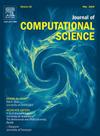Physics-informed neural networks for microflows: Rarefied gas dynamics in cylinder arrays
IF 3.7
3区 计算机科学
Q2 COMPUTER SCIENCE, INTERDISCIPLINARY APPLICATIONS
引用次数: 0
Abstract
Accurate prediction of rarefied gas dynamics is crucial for optimizing flows through microelectromechanical systems, air filtration devices, and shale gas extraction. Traditional methods, such as discrete velocity and direct simulation Monte Carlo (DSMC), demand intensive memory and computation, especially for microflows in non-convex domains. Recently, physics-informed neural networks (PINNs) emerged as a meshless and adaptable alternative for solving non-linear partial differential equations. We trained a PINN using a limited number of DSMC-generated rarefied gas microflows in the transition regime , incorporating continuity and Cauchy momentum exchange equations in the loss function. The PINN achieved under 2 % error on these residuals and effectively filtered DSMC’s intrinsic statistical noise. Predictions remained strong for a tested flow field with , and showed limited extrapolation performance on a flow field with with a local overshoot of about 20 %, while maintaining physical consistency. Notably, each DSMC field required hours on 4 graphics processing units (GPU), while the PINN training took hours on one GPU, with evaluations under seconds.
微流的物理信息神经网络:圆柱体阵列中的稀薄气体动力学
稀薄气体动力学的准确预测对于优化通过微机电系统、空气过滤装置和页岩气开采的流动至关重要。传统的方法,如离散速度和直接模拟蒙特卡罗(DSMC),需要大量的内存和计算,特别是对于非凸域的微流。最近,物理信息神经网络(pinn)作为求解非线性偏微分方程的无网格和适应性替代方案出现。我们使用过渡区(0.1<Kn<3)中有限数量的dsmc生成的稀薄气体微流训练了一个PINN,在损失函数中加入了连续性和柯西动量交换方程。PINN在这些残差上的误差小于2%,并有效地滤除了DSMC的固有统计噪声。对于Kn=0.7的测试流场,预测仍然很强,而对于Kn=5的流场,在保持物理一致性的情况下,外推性能有限,局部超调约为20%。值得注意的是,每个DSMC字段在4个图形处理单元(GPU)上需要20个小时,而PINN训练在一个GPU上需要2个小时,评估不到2秒。
本文章由计算机程序翻译,如有差异,请以英文原文为准。
求助全文
约1分钟内获得全文
求助全文
来源期刊

Journal of Computational Science
COMPUTER SCIENCE, INTERDISCIPLINARY APPLICATIONS-COMPUTER SCIENCE, THEORY & METHODS
CiteScore
5.50
自引率
3.00%
发文量
227
审稿时长
41 days
期刊介绍:
Computational Science is a rapidly growing multi- and interdisciplinary field that uses advanced computing and data analysis to understand and solve complex problems. It has reached a level of predictive capability that now firmly complements the traditional pillars of experimentation and theory.
The recent advances in experimental techniques such as detectors, on-line sensor networks and high-resolution imaging techniques, have opened up new windows into physical and biological processes at many levels of detail. The resulting data explosion allows for detailed data driven modeling and simulation.
This new discipline in science combines computational thinking, modern computational methods, devices and collateral technologies to address problems far beyond the scope of traditional numerical methods.
Computational science typically unifies three distinct elements:
• Modeling, Algorithms and Simulations (e.g. numerical and non-numerical, discrete and continuous);
• Software developed to solve science (e.g., biological, physical, and social), engineering, medicine, and humanities problems;
• Computer and information science that develops and optimizes the advanced system hardware, software, networking, and data management components (e.g. problem solving environments).
 求助内容:
求助内容: 应助结果提醒方式:
应助结果提醒方式:


